




Your support is critical to our success.
Accepted Scientific Name: Echinocereus sciurus (K.Brandegee) Dams
Monatsschr. Kakteenk. 14: 130. 1904. - see also: Britton & Rose in Cactaceae (Britton & Rose) 3: 22. 1922 [12 Oct 1922]
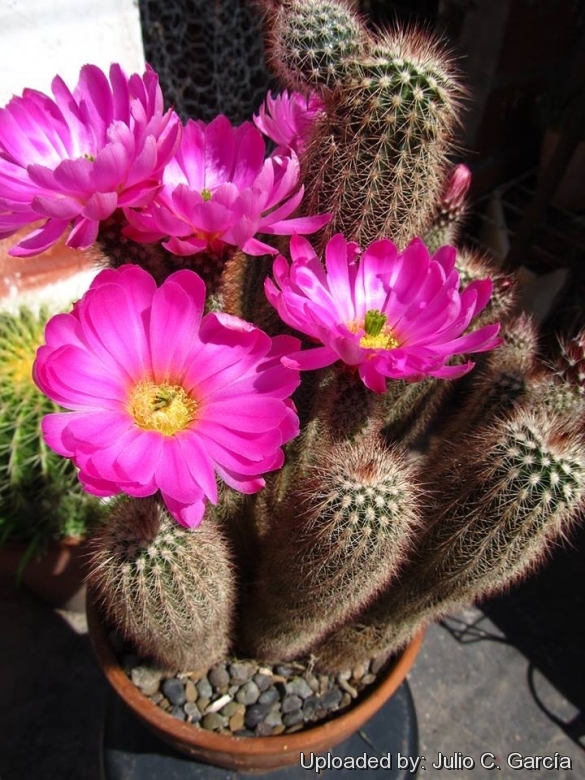
Origin and Habitat: Known only from the Cape District of the peninsula Southern end of Lower California.
Type locality: Hills near San Jose del Cabo, Lower California.
Altitude: 10-200 metres above sea level.
Habitat: In habitat Echinocereus sciurusSN|21867]]SN|8681]] clusters on rocks on hills near the sea in Sonoran Desert and arid subtropical regions. This species has an extent of occurrence of approximately 5,000 km2, the subpopulations are severely fragmented as a result of land use change throughout its range, and it does not occur within any protected areas. The same areas support many endemic succulents and xerophyte plants such as Pachycereus pringleiSN|8572]]SN|8572]], Stenocereus thurberiSN|8265]]SN|8265]], Lophocereus schottiiSN|8344]]SN|8344]], Ferocactus peninsulaeSN|11977]]SN|11977]] var. townsendianus, Echinocereus barthelowanusSN|8681]]SN|21867]], Peniocereus johnstoniiSN|8193]]SN|8193]], Machaerocereus gummosusSN|8115]]SN|8115]], Mammillaria schumannii, Mammillaria armillataSN|5363]]SN|5363]], and Mammillaria peninsularis.
Synonyms:
- Echinocereus sciurus (K.Brandegee) Dams
- Cereus sciurus K.Brandegee
Echinocereus sciurus (K.Brandegee) Dams
Monatsschr. Kakteenk. 14: 130. 1904.
Synonymy: 3
- Echinocereus sciurus (K.Brandegee) Dams
- Cereus sciurus K.Brandegee
- Echinocereus subterraneus Backeb.
Echinocereus sciurus subs. floresii (Backeb.) N.P.Taylor
Cactaceae Consensus Init. 3: 10. 1997
Synonymy: 6
- Echinocereus sciurus subs. floresii (Backeb.) N.P.Taylor
- Echinocereus bristolii subs. floresii (Fritz Schwarz ex Backeb.) W.Blum & Mich.Lange in W.Blum et al.
- Echinocereus floresii Fritz Schwarz
- Echinocereus sciurus var. floresii (Fritz Schwarz ex Backeb.) N.P.Taylor
- Echinocereus sciurus subs. floresii var. Bergform hort.
Description: Echinocereus sciurusSN|8681]]SN|8681]] is a densely cespitose cactus species, with numerous short, upright heads covered with slender short spines, with many individuals forming clumps sometimes 60 cm broad. Two subspecies are recognized, the nominate form and subsp. floresii (Backeb.) N.P.Taylor.
Roots: Tuberous.
Stems: Slender, short, mostly erect, cylindrical, tapered toward the tips, often 20 cm long, nearly hidden by the many spines.
Ribs: 12 to 17, low, on the growth of the year often entirely divided into numerous tubercles 5 to 6 mm Apart
Areoles: Small, approximate, circular, at first woolly, becoming naked 5-8 mm. apart on the same rib.
Spines: 18-22, not differentiated as centrals and radials, slender, brownish to whitish, mostly flattened.
Radial spines: 15 to 18, slender, 3-16 mm long, grey on the older parts, pale yellowish brown except the brownish tip, with darker tips on the young growth.
Central spines: Usually several (1-6), a little stouter but shorter than the radials the longer of which rarely reaching 15 mm, very slender.
Flower: Though normally found at the end of the stems just below the stem tips, flowers may also occur down the sides of the plant 5-8 cm long, 7-12 cm in expansion when fully open. Ovary and tube densely spinose. Inner perianth-segments in 2 to 4 rows, bright pinkish magenta or magenta, paler towards the base the tips erose, acute, the outer surface marked with numerous striations. Stamens numerous, with greenish filaments and yellow anthers. Pistil green with obtuse stigma-lobes. Flower-buds covered with numerous slender brown-tipped spines.
Fruits: Subglobose, reddish green with white pulp.
Seeds: 1 mm long, tuberculate.
Subspecies, varieties, forms and cultivars of plants belonging to the Echinocereus sciurus group
 Echinocereus sciurus (K.Brandegee) Dams: (subsp. sciurus) has flowers 8 cm long and up to 10 cm in expansion when fully open, near the stem tips. Distribution: Baja California Sur.
Echinocereus sciurus (K.Brandegee) Dams: (subsp. sciurus) has flowers 8 cm long and up to 10 cm in expansion when fully open, near the stem tips. Distribution: Baja California Sur. Echinocereus sciurus subs. floresii (Backeb.) N.P.Taylor: has smaller flowers up to 5 cm long and 7 cmacross, well below the stem tips. Distribution: Sinaloa, Mexico.
Echinocereus sciurus subs. floresii (Backeb.) N.P.Taylor: has smaller flowers up to 5 cm long and 7 cmacross, well below the stem tips. Distribution: Sinaloa, Mexico. Echinocereus sciurus subs. floresii var. Bergform hort.: is a mountain form with thinner spines and one (or more) long bristly reddish central spines. Distribution: higher part of the species range, Sinaloa, Mexico.
Echinocereus sciurus subs. floresii var. Bergform hort.: is a mountain form with thinner spines and one (or more) long bristly reddish central spines. Distribution: higher part of the species range, Sinaloa, Mexico.
Bibliography: Major references and further lectures:
1) Edward Anderson “The Cactus family” Timber Press, Incorporated, 2001
2) James Cullen, Sabina G. Knees, H. Suzanne Cubey "The European Garden Flora Flowering Plants: A Manual for the Identification of Plants Cultivated in Europe, Both Out-of-Doors and Under Glass" Cambridge University Press, 11/Aug/2011
3) David R Hunt; Nigel P Taylor; Graham Charles; International Cactaceae Systematics Group. "The New Cactus Lexicon" dh books, 2006
4) Urs Eggli, Leonard E. Newton: “Etymological Dictionary of Succulent Plant Names” Springer, Berlin/Heidelberg 2010
5) N. L. Britton, J. N. Rose: “The Cactaceae. Descriptions and Illustrations of Plants of the Cactus Family.” Volume II, The Carnegie Institution of Washington, Washington 1920
6) John Borg “Cacti: a gardener's handbook for their identification and cultivation” Blandford P., 1970
7) Clive Innes, Charles Glass “Cacti” Portland House, 01/May/1991
8) “Allan Hancock Pacific Expeditions” Volume 13 University of Southern California Press, 1950
9) León de la Luz, J.L., Hernández, H.M. & Gómez-Hinostrosa, C. 2013. Echinocereus sciurus. In: IUCN 2013. “IUCN Red List of Threatened Species.” Version 2013.2. <www.iucnredlist.org>. Downloaded on 11 January 2014.
9) Ulises Guzmán, Salvador Arias, Patricia Dávila "Catálogo de cactáceas mexicanas." Universidad Nacional Autónoma de México, Mexiko-State 2003
10) Backeberg “Blätter fur Sukkulentenkunde. Volksdorf“ volume 1, page. 5. 1949
11) Taylor “Cactaceae Consensus Initiatives” Volume 3, page. 10. 1997
12) Brandegee “Echinocereus sciurus” in: Zoe 5, page 192 1904
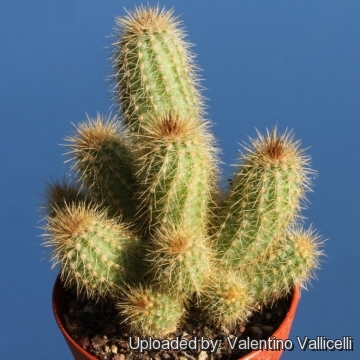
Cereus sciurus (Echinocereus sciurus) Photo by: Valentino Vallicelli
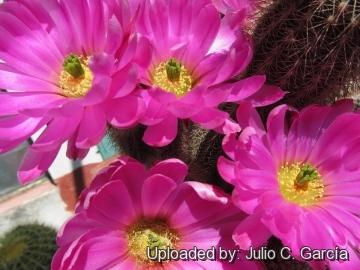
Cereus sciurus (Echinocereus sciurus) Photo by: Julio C. García
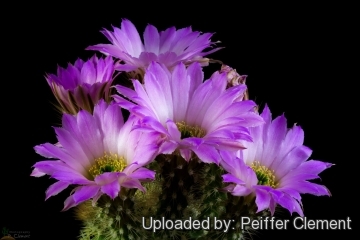
Cereus sciurus (Echinocereus sciurus) Photo by: Peiffer Clement
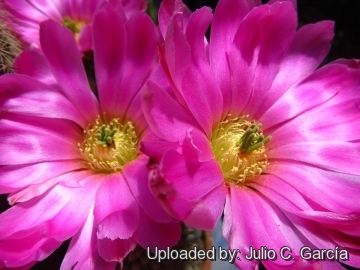
Cereus sciurus (Echinocereus sciurus) Photo by: Julio C. García
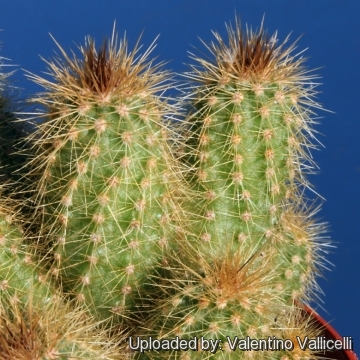
Cereus sciurus (Echinocereus sciurus) Photo by: Valentino Vallicelli
The gallery now contains thousands of pictures, however it is possible to do even more. We are, of course, seeking photos of species not yet shown in the gallery but not only that, we are also looking for better pictures than those already present. Read More...
Cultivation and Propagation: Echinocereus sciurusSN|8681]]SN|8681]] is of relatively easy culture, but has a massive, deep, tuberous root system below the soil and is prone to rot.
Soil: Use a loose well drained cactus mix.
Repotting: It require a deep pot suited to accommodate the swollen root, repotting with fresh potting-mix should be done every other year or when the plant has outgrown its pot. However, repotting doesn't necessarily mean they'll need larger containers.
Sun Exposure: Light shade when young, full sun later. Outside it likes strong sunshine, but is tolerant and do well with light shade during the hot Summer months, inside it needs bright light, and some direct sun. Tends to bronze in strong light, which encourages spine production.
Hardiness: Winter care presents no problems at temperatures from 5 to 15 degrees centigrade with plenty of light, but frost hardy to -5°C for short periods if very dry.
Watering: They require moderately watering through the growing season. This can be done weekly or more frequently during the summertime, if the weather is sunny enough, but allow to dry fully before watering again. Kept this way, plants will show a healthy growth. Keep rather dry as soon as the temperature starts dropping in October and keep it dry in winter. The plant survives outside without protection in winter (cold hardy to -5° ) but is then somewhat prone to rot, too.
Fertilization: Give an occasional high potassium liquid feed during the active growing period.
Garden uses: Excellent as landscape or patio plant. It is suitable for “desert” gardens, in association with other xerophytes. Where the open air cultivation is not possible due to the climate, it is to be cultivated in pot in order to shelter it in winter. It look fine in a cold greenhouse and frame.
Pest and diseases: They are generally fairly easy to grow, especially if kept pest-free. They are susceptible to, scale insects and spider mite. Watch carefully for infestations of stem and root mealy bugs, and damage from these may well initiate fungal attack.
Propagation: Easy to propagate from cuttings or seeds. Take cuttings spring or summer, let them dry till the ends callous well. Then replant them in fresh cactus soil that is ever so slightly moist, and keep it that way till they root. Surface sowing is the best; seeds germinate in 14-28 days at 20° C, remembering that seedlings dislike strong light and dry conditions.
| Your Actions | |
|---|---|
| Back to Cereus index | |
| Back to Cactaceae index | |
 |
Back to Cacti Encyclopedia index |
Privacy stantement - Terms and conditions - How to cite - About us - Feedback - Donate



